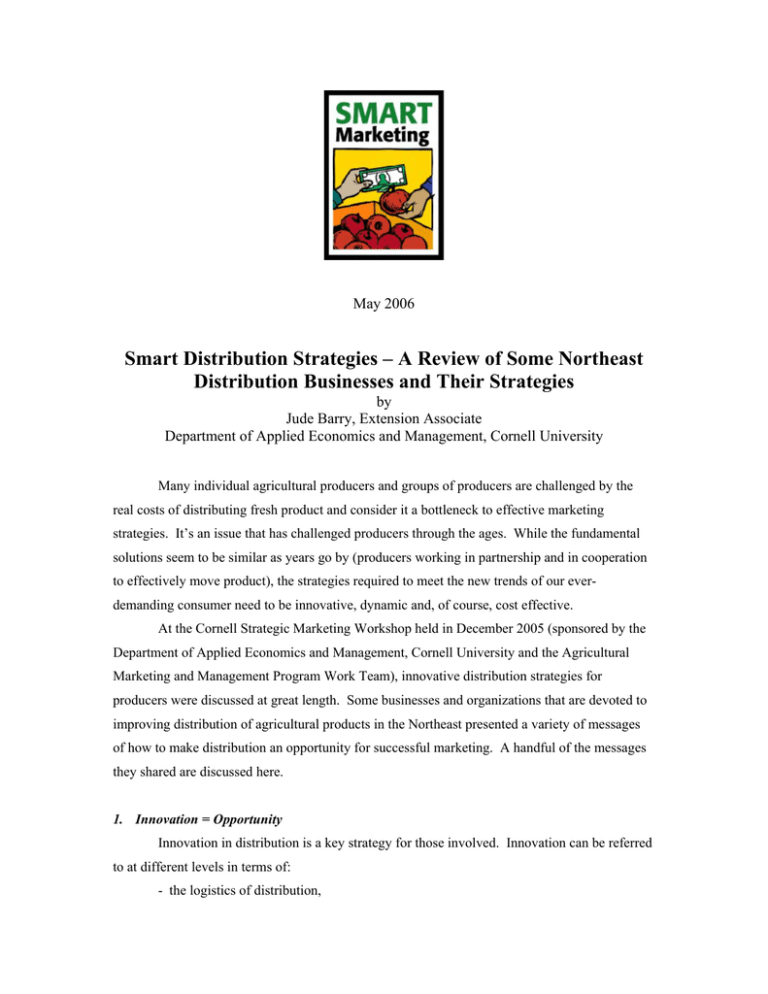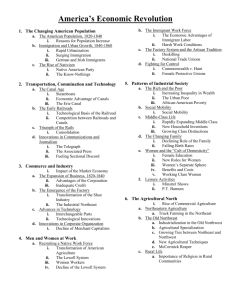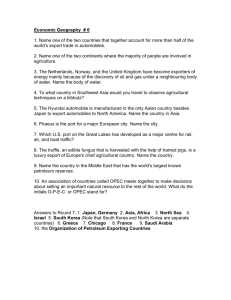Smart Distribution Strategies – A Review of Some Northeast
advertisement

May 2006 Smart Distribution Strategies – A Review of Some Northeast Distribution Businesses and Their Strategies by Jude Barry, Extension Associate Department of Applied Economics and Management, Cornell University Many individual agricultural producers and groups of producers are challenged by the real costs of distributing fresh product and consider it a bottleneck to effective marketing strategies. It’s an issue that has challenged producers through the ages. While the fundamental solutions seem to be similar as years go by (producers working in partnership and in cooperation to effectively move product), the strategies required to meet the new trends of our everdemanding consumer need to be innovative, dynamic and, of course, cost effective. At the Cornell Strategic Marketing Workshop held in December 2005 (sponsored by the Department of Applied Economics and Management, Cornell University and the Agricultural Marketing and Management Program Work Team), innovative distribution strategies for producers were discussed at great length. Some businesses and organizations that are devoted to improving distribution of agricultural products in the Northeast presented a variety of messages of how to make distribution an opportunity for successful marketing. A handful of the messages they shared are discussed here. 1. Innovation = Opportunity Innovation in distribution is a key strategy for those involved. Innovation can be referred to at different levels in terms of: - the logistics of distribution, - the physical movement of product in distribution, - the packaging of the product, and - the choice of target markets for developing distribution strategies. Effective agricultural distribution businesses are looking for innovative strategies at all of these levels. An example of such innovation being adopted is demonstrated by Red Jacket Orchards in Geneva, New York. This business is a vertically integrated family farm that grows fruit in Central New York and then processes, packs and markets the fruit and other products through their own distribution network. The business transports their products and that of others to New York City. In addition to directly delivering weekly to 25 New York City Greenmarkets, the Hunts Point Terminal Market, and a number of restaurants and specialty food stores in the city, they have recently leased 5000 ft2 of warehouse space in Brooklyn to offer more efficient delivery to the smaller purchasers in New York City. They have adopted “innovative” packaging strategies as they work with their different niche markets. This area is very customer driven, and Red Jacket Orchards has worked with their consumers to provide fruit and vegetables in packaging of appropriate size, labeling and shape to attract the niche buyers. The business is continuing to look for innovative partnerships and products with which to develop the business. 2. Observe the Market Trends Understanding trends in the market is vital in keeping ahead of the game with all aspects of marketing including distribution. An organization that presented at the Strategic Marketing Workshop in December and provides services to producers is USDA’s Agricultural Marketing Service (www.ams.usda.gov/tmd/MSB) which strives to improve agricultural product distribution through identifying marketing opportunities and developing solutions and marketing channels. An innovative distribution business that is demonstrating success in the monitoring of trends in the marketplace is Earthbound Farm - the nation’s largest grower shipper of organic produce. At the Strategic Marketing workshop, they reported that external factors to the business, which they called “Megatrends”, were critical in the decision making of their distribution strategy. Industry trends that they track include: - changing models of distribution and transportation, - the need to get business closer to the customer to ensure high quality product can be economically distributed. This includes regional positioning of where the product is 2 grown, the distribution facilities and their employees. Earthbound Farm is building more regional warehouses including a New Jersey location. - the declining supply and rising cost of natural resources, - the availability of labor. Over the years, Earthbound Farm has grown their distribution operations so that they now have their brand in 74% of the supermarkets in the USA (AC Nielsen, ACV data). 3. Diversifying Market Risk through Export Distributing product to different locations and customers is a strategy that can spread the risk that a product is exposed to. Examples of such risk include loss of customers, competition from other products, and insufficient sales volume to cover the fixed costs of a product. Food Export USA – Northeast is a non-profit organization comprised of state agricultural promotion agencies that use federal, state and industry resources to promote the export of northeastern food and agricultural products. In New York State (NYS) they work with NYS Department of Agriculture and Markets. The organization is committed to assisting US suppliers (including small and medium-sized suppliers) through their Export Education, Market Entry and Market Promotion strategies. Through these programs, Food Export USA – Northeast can assist companies to understand and discover new opportunities in the export market. Export may help diversify market risk through expanding market opportunities (although it may also present other risks). If the market is correct, global export can increase sales. In addition, when an innovative food product lifecycle has finished here in the USA (for example alternative products have come onto the market and sales of a particular product have diminished), there may be opportunity to move the product across the border to rejuvenate sales and restart the lifecycle of the product. If the market is diversified and sales are increased, unit costs are reduced, making the product more cost effective to the business. 4. Supply of the Product Good quality, reliable supply is a strategy that smart distributors need to ensure to minimize loss percentage of their deliveries, reduce unnecessary distribution costs and sustain their customer base. David Rose, a representative from Sid Wainer and Son Specialty Produce based in Massachusetts spoke at the Strategic Marketing workshop in December 2005. His business grows and buys specialty produce and distributes it to specialty food buyers through the 3 Northeast, particularly in the metro areas. Like all of our speakers, Sid Wainer and Son is very focused on the needs and demands of the consumer with respect to quality, supply and packaging. They receive and pay a premium price for the product that they handle, but in return require the quality and reliability that the consumer is paying for. In order to do this, they make regular contracts with their suppliers. 5. Partnerships As I mentioned at the start of this article, partnerships and collaborations have always been a fundamental solution to effectively moving product from A to B. Successful partnerships are a key factor in successful distribution activities across the Northeast. An example of collaborative partnerships working can be seen with the Foodlink Distribution Center based in Rochester, New York. Foodlink is a part of the national Food Bank network, and it serves to provide food, nutrition, education and resources to at-risk communities in 10 counties of Central and Western New York. In an effort for this community organization to build self-sufficiency, they have built a distribution business called the Foodlink Farmers Fulfillment Center, using their unique assets of warehouse space, refrigerated trucks, coolers, repacking facilities and freezer space. Foodlink partners with Freshlink Farms, Red Jacket Orchards and Pederson Farms to supply local New York Produce to schools, wholesalers, suppliers and restaurants in the Greater Rochester Area. In Summary Distribution strategies vary from business to business. Being unique and innovative in the way a product is distributed, understanding the target market and controlling risk factors through distribution can help develop a good marketing strategy for a product. Being able to sustain a reliable throughput of product in the distribution chain, and building strong partnerships can be effective strategies for smart marketing distribution operatives in the Northeast. Resources Distribution businesses represented at the Strategic Marketing Workshop in December 2005 and that are mentioned in this article: • David Rose, Sid Wainer and Son Specialty Produce, New Bedford, MA (www.sidwainer.com). • Brian Nicholson, Red Jacket Orchards, Geneva, NY (http://secure.redjacketorchards.com). 4 • Edward Ragland, Agricultural Marketing Service, USDA, Washington, DC (www.ams.usda.gov/tmd/MSB). • Joy Canono, Generic Program Manager, Food Export USA – Northeast; Philadelphia, PA (www.foodexportusa.org). • Karen Pflaum and Todd Kodet, VP Supply, Earthbound Farm, San Juan Bautista, CA (www.ebfarm.com). • Tom Ferraro and John Montague, FoodLink, Rochester, NY (www.buyhereny.com). This year’s Cornell Strategic Marketing Workshop will be held on 14th-15th November, 2006 and will provide information on improving producer marketing skills to different local and regional buyers. "Smart Marketing" is a monthly marketing newsletter for extension publication in local newsletters and for placement in local media. It reviews the elements critical to successful marketing in the food and agricultural industry. Articles are written by faculty members in the Department of Applied Economics and Management at Cornell University. "Share the gift of communication." Please cite or acknowledge when using this material. 5




